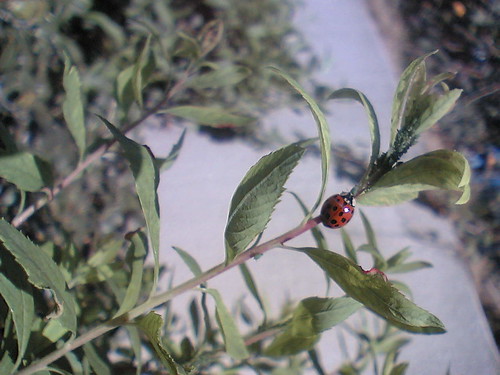 These were one of the last ladybirds I saw mid-winter at Gumyoji Park last year.
These were one of the last ladybirds I saw mid-winter at Gumyoji Park last year.
Ladybird factoids
Worldwide there are more than 5,200 species of ladybirds and 180 species of these live in Japan – compare that to 41 species in the UK. North America introduced Japanese ladybirds to battle against the accidentally introduced woolly adelgid (small-sap-sucking Asian aphid) that has been killing hemlock trees along the East Coast.
According to The Big Bug Book, most ladybirds are red with black spots. Some have yellow or white spots or multi-clored markings and some have stripes instead of spots while others are black with no markings at all.
Other insects and bugs usually pass the winter as larva but ladybirds can live longer than a year so they hibernate underground unlike most other insects. The adults retreat into dry sheltered sites overwintering there often in large groups.
This kind of ladybird has white false eyes. The pale markings that look like eyes are actually on the thorax.
Most ladybirds are brightly coloured (red, yellow or orange) with black spots. These colours warn predators that ladybirds taste horrible. This is the best shot of a ladybird that I took today.
One ladybird can eat up to 50 aphids a day. During the late 1800s ladybirds were used to control Icerya purchasi, the cottony cushion scale – a bug that threatened to destroy all the lemon trees in California, USA.
Yellow ladybird. Ladybirds are small ranging in size from just 0.3 mm to 10 mm long. This was the smallest I had ever seen about 3 mm long.
Did you know that the color of the ladybug changes as it gets older and sometimes the adult one doesn’t look anything like the young ones. (Picture is from last summer)
 Ladybirds are my favorite sort of beetle, and a gardeners’ best friend though it’s only the red and black spotted one that eats up the aphids.
Ladybirds are my favorite sort of beetle, and a gardeners’ best friend though it’s only the red and black spotted one that eats up the aphids.
The only kind of ladybird that doesn’t eat the plants up is the ladybird that has a red wingcase (elytra) with 7 black spots on its back – called the Seven Spot Ladybird or Coccinella 7-punctata. Originally they were called Our Lady’s Bird referring to Our Lady, the Virgin Mary with the red of the wing cases representing her cloak and the seven black spots are supposed to be her seven joys and seven sorrows.
A little experiment – as I made a ladybird crawl on my hand, I observed that as it prepares to fly off, it usually crawls to the highest point of my hand and launches off.
This ladybird is munching an aphid in its jaws!
It is also oozing a yellow fluid – see the yellow dots on its cheeks. It gives out the yellow fluid when it thinks it’s attacked. That yellow fluid is a little smelly.
This particular aphid has about 14 spots and is the Anatis ocellata.
Ladybirds are the only insects that many people will touch because they are known to be harmless. There are more than 4,000 different types of ladybirds in temperate and tropical countries.






